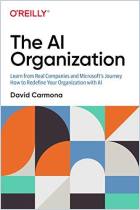Зарегистрируйтесь на getAbstract, чтобы получить доступ к этому краткому изложению.

Зарегистрируйтесь на getAbstract, чтобы получить доступ к этому краткому изложению.
David Carmona and Guillermo Carmona
Responsibility: Responsible AI in Action
Microsoft AI Business School Podcast Episode 3
Microsoft, 2020
Что внутри?
As AI becomes crucial to business, companies look for ways to eliminate machine-learning biases.
Recommendation
With AI technology quickly becoming essential to business, ensuring these technologies are handled in a way that puts people first and makes the responsible use of AI a cornerstone of innovation is vital. This Microsoft AI Business School podcast, led by David Carmona, general manager for AI and innovation, discusses how to put Responsible AI in action with other experts.
Take-Aways
- Considering the pace with which AI is advancing, it’s critical to retain society’s trust.
- Responsible AI begins with organizations defining their values through a set of principles.
- Putting Responsible AI into action requires principles, practices, governance, and tools.
Summary
Considering the pace with which AI is advancing, it’s critical to retain society’s trust.
Natasha Crampton, Microsoft’s chief responsible AI officer, thinks companies must treat AI like security and privacy, as a “core element of trust.”
“We know that people don’t use technology that they don’t trust, and so making sure that we are baking in responsible AI considerations when we’re building the technology, also when we’re deploying the technology, is really just an essential part of unlocking the value of these promising new AI technologies.” (Natasha Crampton)
Sarah Bird, Microsoft’s former leader of responsible AI for Azure Machine Learning, believes that internal communications should begin with discussions of ethics, technology and society. Crampton adds that open communication is central, and we must be humble enough to admit that they don’t always have the necessary answers.
Responsible AI begins with organizations defining their values through a set of principles.
Microsoft’s 2018 book The Future Computed established responsible AI principles, delineating the company’s approach to its challenges. Carmona thinks every company must “take a stand” in how it will address these challenges. Microsoft formed a committee known as Aether, which stands for AI Ethics and Effects on Engineering and Research. Aether serves as a think tank that promotes discussion between people who have a variety of backgrounds. Its work groups provide guidance for initiatives such as interpretability algorithms.
“This work resulted in six principles about our shared responsibility in AI in Microsoft – fairness, reliability and safety, privacy and security, inclusiveness, transparency, and accountability.” (David Carmona)
Since establishing those principles, Carmona says new obstacles have popped up, such as those relating to deep fakes and facial recognition. Nick McQuire, chief of enterprise research for CCS Insight, says his company has recently become aware of the importance of investing in interpretability, security and especially privacy. He points out that the shift to this level of priority has emerged in the past year, indicating an increased awareness of responsible AI.
McQuire thinks that when companies see AI technology becoming crucial to their aim, they’ll integrate it into key operational processes and begin to recognize the hazards and responsibilities they might incur with dependence on machine learning and AI.
“Responsible AI requires a culture transformation.” (David Carmona)
AI must be inclusive and fair, with no exclusions due to race, gender or where people live. AI can learn bias through training algorithms. It’s a “people” job to understand how to check the system’s models and accountability. A diverse team embracing open attitudes and listening to community groups helps to develop non-biased principles and tools.
Putting Responsible AI into action requires principles, practices, governance, and tools.
Companies should establish a governing body that develops guidelines and best practices for implementing AI across the development lifecycle.
The Office of Responsible AI (ORA) puts governance models into practice at Microsoft. Any such framework within an organization should make responsibilities and roles clear, while offering support and advice.
One of McQuire’s bank clients installed a machine learning process that builds bias checks and diversity into the data fed into its AI structures. Carmona’s Microsoft framework makes sure that no one person oversees responsible AI. Various teams share it, with individuals understanding their specific roles, and how that affects overall governance. Building in metrics helps measure how well a team is serving its goals.
“There’s no tool that helps you with this part of the process. This is really just thought work, it’s really about reframing the way that you think about the technology that you’re building. And for me, it’s just really heartening to see that more holistic perspective coming out.” (Natasha Crampton)
Microsoft’s ORA implemented its Responsible AI Champs Program to scale AI practices and guidelines across the company and create awareness. This reinforces cultural change through leadership. AI champs use “impact assessment” to understand how AI technology affects society and individuals.
“What we’re starting to see is…best practices emerg[ing] from some of the more mature organizations with respect to machine learning [which] are heavily pivoting to responsible approaches that fundamentally help them increase agility and bypass challenges that will slow them down, down the road.” (Nick McQuire)
Microsoft is developing tools that focus on data protection, understanding and assessing bias in AI models, and governing/auditing AI processes.
Responsible AI tools include FairLearn, Azure Machine Learning and Interpret ML. These tools are created in open source, so that experts can verify and implement best practices, while moving the technology forward.
Carmona offers three recommendations for developing responsible AI:
- Establish responsible AI principles that define and address problems within a specific organization.
- Create a process for governance that incorporates responsible AI throughout the organization.
- Thoughtfully analyze technology and tools that help create robust responsible AI.
Carmona recommends humility for people dealing with responsible AI. No one possesses all the solutions and answers. People must learn from other organizations with diverse perspectives.
About the Podcast
Host David Carmona is general manager for AI and innovation at Microsoft. In this Microsoft AI Business School podcast, he interviews guests Sarah Bird, former leader of responsible AI for Azure Machine Learning; Natasha Crampton, Microsoft’s chief responsible AI officer; and Nick McQuire, who leads CCS Insight’s enterprise and artificial intelligence research.
This document is restricted to personal use only.




















Comment on this summary